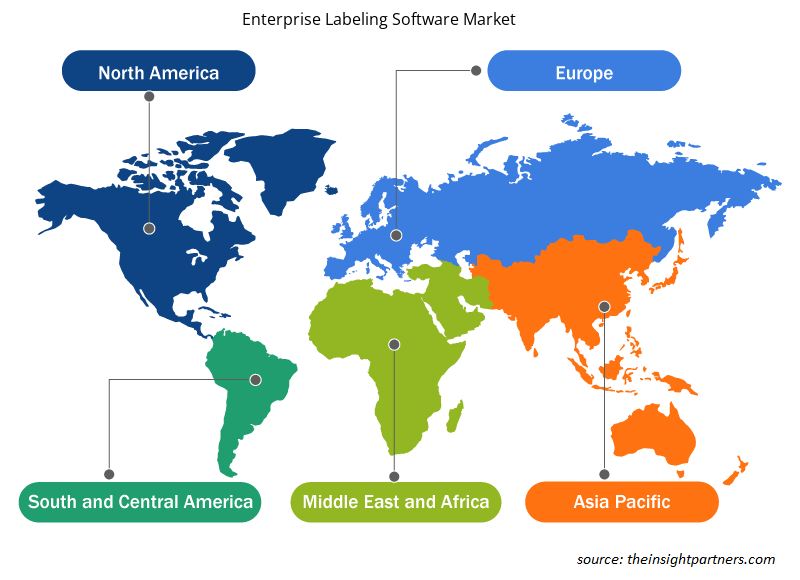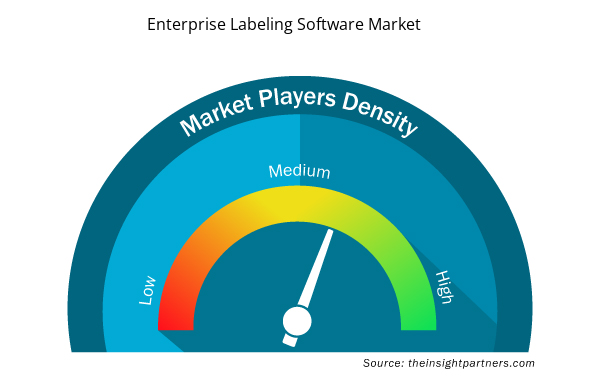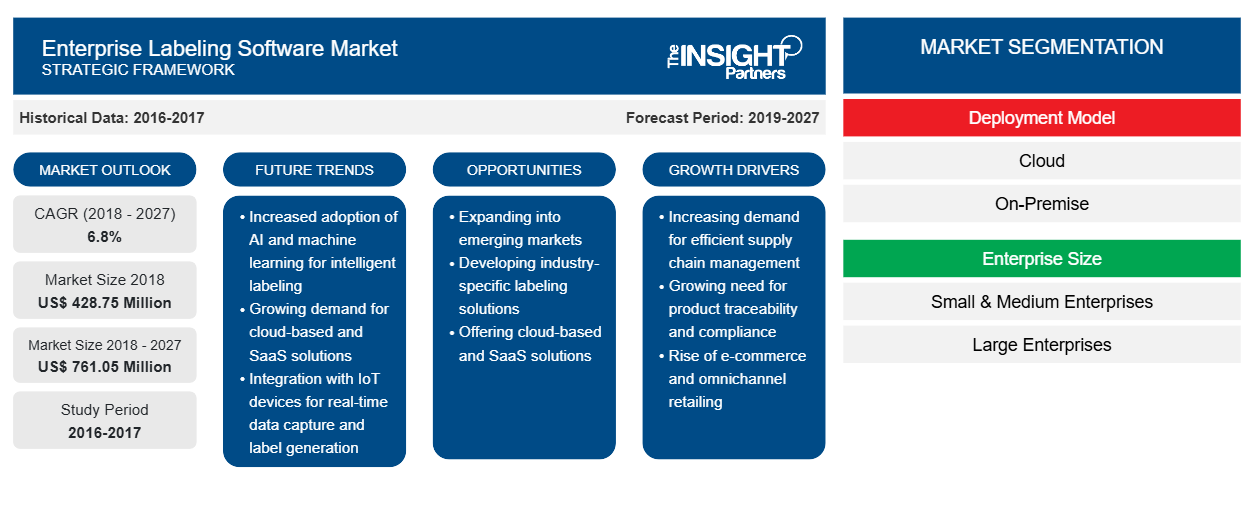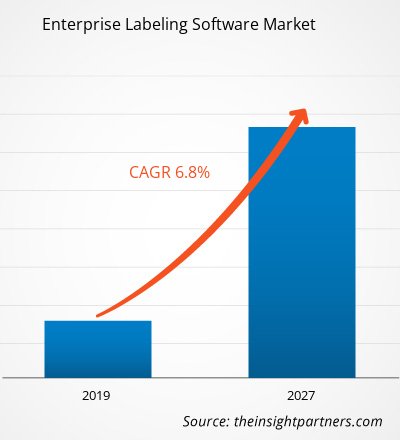Der Markt für Unternehmenskennzeichnungssoftware wurde im Jahr 2018 auf 428,75 Millionen US-Dollar geschätzt und soll bis 2027 einen Wert von 761,05 Millionen US-Dollar erreichen, was einer durchschnittlichen jährlichen Wachstumsrate von 6,8 % während des Prognosezeitraums entspricht.
Die Expansion verschiedener Endverbrauchsbranchen auf der ganzen Welt, insbesondere in APAC und MEA, sowie die Entwicklung des Datenmanagements und der Planung in den letzten Jahren haben die Etikettierung für viele kleine und mittlere Unternehmen zu einem geschäftskritischen Vorgang gemacht. In verschiedenen Endverbrauchsbranchen besteht ein zunehmender Bedarf an Unternehmensetikettierung, um mehrere Geschäftsabläufe zu rationalisieren. Die Unternehmensetikettierungssoftware hilft dabei, die Genauigkeit während des Druckvorgangs aufrechtzuerhalten und stellt sicher, dass Unternehmen die Vorschriften zur Offenlegung von Produktinformationen einhalten. Darüber hinaus bietet die Integration dieser Software verschiedene Vorteile, darunter Datenzusammenarbeit auf Unternehmensebene, Effizienz der Lieferkette sowie Flexibilität und Konsistenz beim Etikettendruck. Daher wird erwartet, dass die zunehmende Einführung der Unternehmensetikettierung das Wachstum des Marktes für Unternehmensetikettierungssoftware vorantreiben wird.
Die Etikettiersoftware für Unternehmen verbessert Geschwindigkeit, Genauigkeit, Effizienz, Kosteneinsparungen und Lieferzeiten und ermöglicht es Unternehmen, komplexe Etikettieraufgaben zu bewältigen. Die verbesserte Etikettierqualität trägt dazu bei, den Wettbewerbsvorteil des Unternehmens auf dem globalen Markt zu steigern.
Passen Sie diesen Bericht Ihren Anforderungen an
Sie erhalten kostenlose Anpassungen an jedem Bericht, einschließlich Teilen dieses Berichts oder einer Analyse auf Länderebene, eines Excel-Datenpakets sowie tolle Angebote und Rabatte für Start-ups und Universitäten.
- Holen Sie sich die wichtigsten Markttrends aus diesem Bericht.Dieses KOSTENLOSE Beispiel umfasst eine Datenanalyse von Markttrends bis hin zu Schätzungen und Prognosen.
Regionale Einblicke in den Markt für Unternehmensetikettierungssoftware
Die regionalen Trends und Faktoren, die den Markt für Enterprise Labeling Software im Prognosezeitraum beeinflussen, wurden von den Analysten von Insight Partners ausführlich erläutert. In diesem Abschnitt werden auch die Marktsegmente und die Geografie von Enterprise Labeling Software in Nordamerika, Europa, im asiatisch-pazifischen Raum, im Nahen Osten und Afrika sowie in Süd- und Mittelamerika erörtert.

- Erhalten Sie regionale Daten zum Markt für Enterprise-Etikettierungssoftware
Umfang des Marktberichts zur Unternehmenskennzeichnungssoftware
| Berichtsattribut | Details |
|---|---|
| Marktgröße im Jahr 2018 | 428,75 Millionen US-Dollar |
| Marktgröße bis 2027 | 761,05 Millionen US-Dollar |
| Globale CAGR (2018 - 2027) | 6,8 % |
| Historische Daten | 2016-2017 |
| Prognosezeitraum | 2019–2027 |
| Abgedeckte Segmente | Nach Bereitstellungsmodell
|
| Abgedeckte Regionen und Länder | Nordamerika
|
| Marktführer und wichtige Unternehmensprofile |
|
Dichte der Marktteilnehmer für Enterprise-Etikettierungssoftware: Die Auswirkungen auf die Geschäftsdynamik verstehen
Der Markt für Enterprise Labeling Software wächst rasant, angetrieben durch die steigende Nachfrage der Endnutzer aufgrund von Faktoren wie sich entwickelnden Verbraucherpräferenzen, technologischen Fortschritten und einem größeren Bewusstsein für die Vorteile des Produkts. Mit steigender Nachfrage erweitern Unternehmen ihr Angebot, entwickeln Innovationen, um die Bedürfnisse der Verbraucher zu erfüllen, und nutzen neue Trends, was das Marktwachstum weiter ankurbelt.
Die Marktteilnehmerdichte bezieht sich auf die Verteilung der Firmen oder Unternehmen, die in einem bestimmten Markt oder einer bestimmten Branche tätig sind. Sie gibt an, wie viele Wettbewerber (Marktteilnehmer) in einem bestimmten Marktraum im Verhältnis zu seiner Größe oder seinem gesamten Marktwert präsent sind.
Die wichtigsten auf dem Markt für Unternehmenskennzeichnungssoftware tätigen Unternehmen sind:
- BLUE Software, LLC
- CYBRA Corporation
- Data Systems International, Inc. (DSI)
- Endicia,
- Euro Plus Ltd.
Haftungsausschluss : Die oben aufgeführten Unternehmen sind nicht in einer bestimmten Reihenfolge aufgeführt.

- Überblick über die wichtigsten Akteure auf dem Markt für Enterprise-Etikettierungssoftware
Die Akteure auf dem Markt für Enterprise Content Management konzentrieren sich auf Strategien wie Fusionen, Übernahmen und Marktinitiativen, um ihre Position auf dem Markt zu behaupten. Nachfolgend sind einige Entwicklungen der wichtigsten Akteure aufgeführt:
- Im November 2019 brachte NiceLabel Version 2 seines ABAP-Pakets auf den Markt, das sowohl SAP ECC als auch SAP S/4HANA unterstützt. Damit können Unternehmen den Qualitätssicherungsprozess bei der Etikettierung vollständig digitalisieren und sowohl Etikettierfehler als auch Versandverzögerungen reduzieren.
- Im April 2018 gab Innovatum, Inc. die ISO 9001:2015-Zertifizierung für sein Qualitätsmanagementsystem für Softwareentwicklung, -bereitstellung und -support als Life-Sciences-Softwareanbieter durch eine von der ANAB akkreditierte Stelle bekannt.
Globale Marktsegmente für Unternehmenskennzeichnungssoftware:
Markt für Enterprise-Etikettierungssoftware – nach Bereitstellungsmodell
- Vor Ort
- Wolke
Markt für Unternehmenskennzeichnungssoftware – nach Unternehmensgröße
- Kleine und mittlere Unternehmen
- Große Unternehmen
Markt für Enterprise-Etikettierungssoftware – nach Endbenutzer
- Konsumgüter
- Einzelhandel
- Gesundheitspflege
- Lagerhaltung und Logistik
- Sonstiges
Markt für Enterprise-Etikettierungssoftware – nach Geografie
Nordamerika
- UNS
- Kanada
- Mexiko
Europa
- Frankreich
- Deutschland
- Italien
- Spanien
- Vereinigtes Königreich
- Restliches Europa
Asien-Pazifik (APAC)
- Australien
- China
- Indien
- Japan
- Restlicher Asien-Pazifik-Raum
Naher Osten und Afrika (MEA)
- Saudi-Arabien
- Vereinigte Arabische Emirate
- Südafrika
- Rest von MEA
Südamerika (SAM)
- Brasilien
- Rest von SAM
Unternehmen
- BLUE Software, LLC (Esko)
- CYBRA Corporation
- Data Systems International, Inc. (DSI)
- Endicia
- Euro Plus Ltd
- Innovatum, Inc.
- Loftware, Inc.
- PRISYM ID Ltd.
- Seagull Scientific, Inc.
- Teklynx Newco SAS
- Historische Analyse (2 Jahre), Basisjahr, Prognose (7 Jahre) mit CAGR
- PEST- und SWOT-Analyse
- Marktgröße Wert/Volumen – Global, Regional, Land
- Branche und Wettbewerbsumfeld
- Excel-Datensatz



Report Coverage
Revenue forecast, Company Analysis, Industry landscape, Growth factors, and Trends

Segment Covered
This text is related
to segments covered.

Regional Scope
North America, Europe, Asia Pacific, Middle East & Africa, South & Central America

Country Scope
This text is related
to country scope.
Häufig gestellte Fragen
Various end-use industries have used reporting solutions and business intelligence (BI) with many of their enterprise applications to improve business operations. Companies are looking forward to using BI to monitor labels printed across facilities to ensure that the quality of labels printed is in line with the expected output of a facility. Moreover, they are looking forward to using this insight for better maintenance schedules for printers and analyzing trends in the label production to fine-tune labeling environments. Therefore, the use of analytics with enterprise labeling is a major emerging trend for enterprise labeling software market.
The growth of the enterprise labeling software market in Europe is primarily attributed to the strong retail industry in countries such as India, China, and Japan, owing to the strong customer base. Also, the FMCG industry in countries such as India and China plays a vital role in supporting any country’s economy. Since the demand for enterprise labeling software is high across the FMCG sector; therefore, a strong FMCG sector supports the increasing demand for enterprise labeling software in the region.
The growing demand for enterprise labeling software in end-use industries in emerging economies such as MEA and APAC is driving the growth of enterprise labeling software market. Also, the surging demand for flexible enterprise labeling solutions to reduce the inconsistency, and improve efficiency is also a major driving factor for the enterprise labeling software market.
Trends and growth analysis reports related to Technology, Media and Telecommunications : READ MORE..
The List of Companies
- BLUE Software, LLC
- CYBRA Corporation
- Data Systems International, Inc. (DSI)
- Endicia,
- Euro Plus Ltd.
- Innovatum, Inc.
- Loftware, Inc.
- PRISYM ID Ltd.
- Seagull Scientific, Inc.
- Teklynx Newco SAS.
The Insight Partners performs research in 4 major stages: Data Collection & Secondary Research, Primary Research, Data Analysis and Data Triangulation & Final Review.
- Data Collection and Secondary Research:
As a market research and consulting firm operating from a decade, we have published and advised several client across the globe. First step for any study will start with an assessment of currently available data and insights from existing reports. Further, historical and current market information is collected from Investor Presentations, Annual Reports, SEC Filings, etc., and other information related to company’s performance and market positioning are gathered from Paid Databases (Factiva, Hoovers, and Reuters) and various other publications available in public domain.
Several associations trade associates, technical forums, institutes, societies and organization are accessed to gain technical as well as market related insights through their publications such as research papers, blogs and press releases related to the studies are referred to get cues about the market. Further, white papers, journals, magazines, and other news articles published in last 3 years are scrutinized and analyzed to understand the current market trends.
- Primary Research:
The primarily interview analysis comprise of data obtained from industry participants interview and answers to survey questions gathered by in-house primary team.
For primary research, interviews are conducted with industry experts/CEOs/Marketing Managers/VPs/Subject Matter Experts from both demand and supply side to get a 360-degree view of the market. The primary team conducts several interviews based on the complexity of the markets to understand the various market trends and dynamics which makes research more credible and precise.
A typical research interview fulfils the following functions:
- Provides first-hand information on the market size, market trends, growth trends, competitive landscape, and outlook
- Validates and strengthens in-house secondary research findings
- Develops the analysis team’s expertise and market understanding
Primary research involves email interactions and telephone interviews for each market, category, segment, and sub-segment across geographies. The participants who typically take part in such a process include, but are not limited to:
- Industry participants: VPs, business development managers, market intelligence managers and national sales managers
- Outside experts: Valuation experts, research analysts and key opinion leaders specializing in the electronics and semiconductor industry.
Below is the breakup of our primary respondents by company, designation, and region:

Once we receive the confirmation from primary research sources or primary respondents, we finalize the base year market estimation and forecast the data as per the macroeconomic and microeconomic factors assessed during data collection.
- Data Analysis:
Once data is validated through both secondary as well as primary respondents, we finalize the market estimations by hypothesis formulation and factor analysis at regional and country level.
- Macro-Economic Factor Analysis:
We analyse macroeconomic indicators such the gross domestic product (GDP), increase in the demand for goods and services across industries, technological advancement, regional economic growth, governmental policies, the influence of COVID-19, PEST analysis, and other aspects. This analysis aids in setting benchmarks for various nations/regions and approximating market splits. Additionally, the general trend of the aforementioned components aid in determining the market's development possibilities.
- Country Level Data:
Various factors that are especially aligned to the country are taken into account to determine the market size for a certain area and country, including the presence of vendors, such as headquarters and offices, the country's GDP, demand patterns, and industry growth. To comprehend the market dynamics for the nation, a number of growth variables, inhibitors, application areas, and current market trends are researched. The aforementioned elements aid in determining the country's overall market's growth potential.
- Company Profile:
The “Table of Contents” is formulated by listing and analyzing more than 25 - 30 companies operating in the market ecosystem across geographies. However, we profile only 10 companies as a standard practice in our syndicate reports. These 10 companies comprise leading, emerging, and regional players. Nonetheless, our analysis is not restricted to the 10 listed companies, we also analyze other companies present in the market to develop a holistic view and understand the prevailing trends. The “Company Profiles” section in the report covers key facts, business description, products & services, financial information, SWOT analysis, and key developments. The financial information presented is extracted from the annual reports and official documents of the publicly listed companies. Upon collecting the information for the sections of respective companies, we verify them via various primary sources and then compile the data in respective company profiles. The company level information helps us in deriving the base number as well as in forecasting the market size.
- Developing Base Number:
Aggregation of sales statistics (2020-2022) and macro-economic factor, and other secondary and primary research insights are utilized to arrive at base number and related market shares for 2022. The data gaps are identified in this step and relevant market data is analyzed, collected from paid primary interviews or databases. On finalizing the base year market size, forecasts are developed on the basis of macro-economic, industry and market growth factors and company level analysis.
- Data Triangulation and Final Review:
The market findings and base year market size calculations are validated from supply as well as demand side. Demand side validations are based on macro-economic factor analysis and benchmarks for respective regions and countries. In case of supply side validations, revenues of major companies are estimated (in case not available) based on industry benchmark, approximate number of employees, product portfolio, and primary interviews revenues are gathered. Further revenue from target product/service segment is assessed to avoid overshooting of market statistics. In case of heavy deviations between supply and demand side values, all thes steps are repeated to achieve synchronization.
We follow an iterative model, wherein we share our research findings with Subject Matter Experts (SME’s) and Key Opinion Leaders (KOLs) until consensus view of the market is not formulated – this model negates any drastic deviation in the opinions of experts. Only validated and universally acceptable research findings are quoted in our reports.
We have important check points that we use to validate our research findings – which we call – data triangulation, where we validate the information, we generate from secondary sources with primary interviews and then we re-validate with our internal data bases and Subject matter experts. This comprehensive model enables us to deliver high quality, reliable data in shortest possible time.


 Holen Sie sich ein kostenloses Muster für diesen Bericht
Holen Sie sich ein kostenloses Muster für diesen Bericht